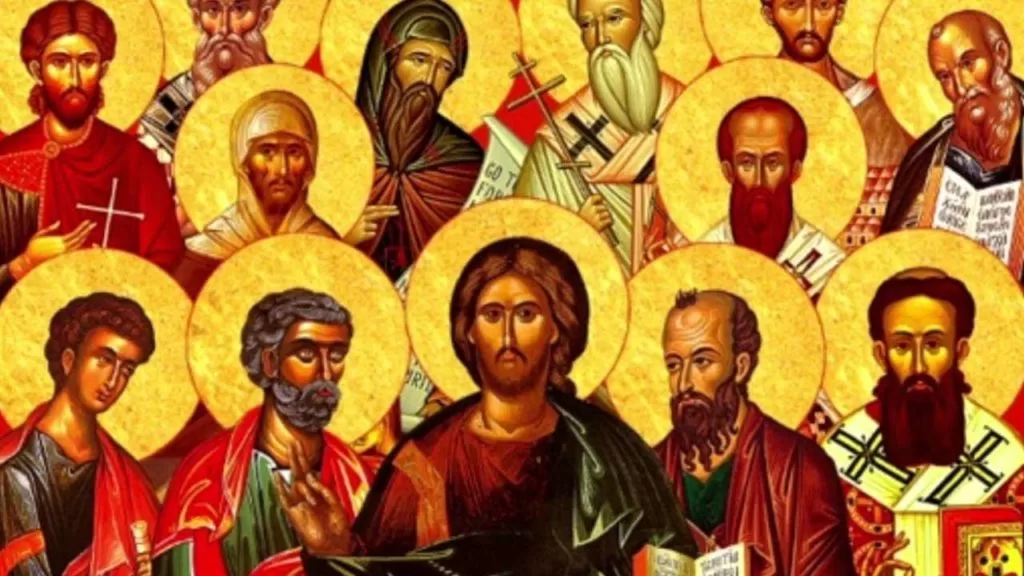جدوى الاقتباسات الابائية في تكوين نص العهد الجديد – جورج ناصر (1)
جدوى الاقتباسات الابائية في تكوين نص العهد الجديد - جورج ناصر (1)
جدوى الاقتباسات الابائية في تكوين نص العهد الجديد – جورج ناصر (1)

- [i]لقد تم تشبيه آباء الكنيسة بحجر رشيد للنقد النصي للعهد الجديد.” [1]
- “الاستشهادات الآبائية ضرورية لتأسيس نص العهد الجديد ، خاصة في الفترة الأولى.” [2]
- “إن الاقتباسات من العهد الجديد في كتابات الآباء لها أهمية قصوى في النقد النصي.” [3]
- “إن كتابات آباء الكنيسة تزودنا بأدلة لا تقدر بثمن على التاريخ المبكر لنص العهد الجديد.” [4]
- “الأدلة الآبائية لا تقدر بثمن في إعادة بناء النص الأصلي للعهد الجديد.” [5]
- “الأدلة الآبائية ، عندما تستخدم بشكل صحيح ، هي أداة رئيسية في يد الناقد النصي.” [6]
- “توفر الأدلة الآبائية أحد أهم أنواع الأدلة على نص العهد الجديد.” [7]
- “الأدلة الآبائية ضرورية لتأسيس النص الأصلي للعهد الجديد.” [8]
- “تقدم الاقتباسات الآبائية أقدم دليل على نص العهد الجديد.” [9]
- “الأدلة الآبائية ضرورية في تحديد التاريخ النصي للعهد الجديد.” [10]
- “الاستشهادات الآبائية حاسمة في إعادة بناء التاريخ المبكر لنص العهد الجديد.” [11]
- “الأدلة الآبائية هي أداة مهمة لإعادة بناء نص العهد الجديد.” [12]
- “الاستشهادات الآبائية هي بعض من أقدم وأهم الأدلة على نص العهد الجديد.” [13]
- “الأدلة الآبائية حاسمة في تحديد الشكل الأول لنص العهد الجديد.” [14]
- “الأدلة الآبائية ضرورية للناقد النصي الذي يسعى إلى إعادة بناء الشكل الأصلي لنص العهد الجديد.” [15]
- “يقدم آباء الكنيسة شهادة لا تقدر بثمن للأشكال الأولى لنص العهد الجديد.” [16]
- “الأدلة الآبائية لا غنى عنها لفهم تطور نص العهد الجديد.” [17]
- “الاستشهادات الآبائية هي أداة رئيسية في إعادة بناء نص العهد الجديد.” [18]
- “الأدلة الآبائية حاسمة في تأسيس نص العهد الجديد.” [19]
- “الاستشهادات الآبائية هي مصدر لا غنى عنه للأدلة على التاريخ المبكر لنص العهد الجديد.” [20]
- “الأدلة الآبائية هي مصدر مهم للناقد النصي في إعادة بناء الشكل الأول لنص العهد الجديد.” [21]
- “تقدم الاقتباسات الآبائية دليلا مهما على التاريخ النصي للعهد الجديد.” [22]
- “الأدلة الآبائية هي مساعدة مهمة في تحديد التاريخ المبكر لنص العهد الجديد.” [23]
- “الاستشهادات الآبائية لا تقدر بثمن لدراسة نص العهد الجديد ونقله.” [24]
- “تقدم الاستشهادات الآبائية دليلا مهما على نص العهد الجديد وتفسيره في الكنيسة الأولى.” [25]
- “الاستشهادات الآبائية هي مورد قيم للناقد النصي في إعادة بناء تاريخ نص العهد الجديد.” [26]
- “الأدلة الآبائية ضرورية لفهم النقل المبكر والتاريخ النصي للعهد الجديد.” [27]
- “الاقتباسات الآبائية ضرورية لدراسة نص العهد الجديد وتطوره في الكنيسة الأولى.” [28]
- “الاستشهادات الآبائية هي مساعدة كبيرة في تأسيس نص العهد الجديد.” [29]
- “توفر الأدلة الآبائية أدلة مهمة على الشكل الأول لنص العهد الجديد.” [30]
- “الاقتباسات الآبائية هي مصدر قيم للناقد النصي في إعادة بناء الشكل الأصلي لنص العهد الجديد.” [31]
- “الأدلة الآبائية هي أداة مهمة للناقد النصي في تقييم المتغيرات النصية للعهد الجديد.” [32]
- “الاقتباسات الآبائية هي مصدر أساسي لإعادة بناء الشكل الأصلي لنص العهد الجديد.” [33]
- “توفر الأدلة الآبائية دعما مهما لقراءات نص العهد الجديد.” [34]
- “الاقتباسات الآبائية هي شاهد قيم على نص العهد الجديد وتطوره.” [35]
- “الأدلة الآبائية ضرورية لفهم نقل نص العهد الجديد في الكنيسة الأولى.” [36]
- “الاستشهادات الآبائية هي مساعدة كبيرة في تأسيس النص الأصلي للعهد الجديد.” [37]
- “الأدلة الآبائية هي مورد مهم لإعادة بناء تاريخ نص العهد الجديد ونقله.” [38]
- “تقدم الاقتباسات الآبائية دليلا قيما على التاريخ النصي للعهد الجديد وتفسيره في الكنيسة الأولى.” [39]
- “الأدلة الآبائية ضرورية لإعادة بناء التاريخ النصي للعهد الجديد.” [40]
- “الاقتباسات الآبائية هي مصدر حاسم لإعادة بناء تاريخ نص العهد الجديد وتفسيره.” [41]
- “الأدلة الآبائية هي مصدر مهم لفهم نقل نص العهد الجديد في الكنيسة الأولى.” [42]
- “الاقتباسات الآبائية هي شهادة قيمة على نص العهد الجديد وتطوره في الكنيسة الأولى.” [43]
- “الأدلة الآبائية هي أداة أساسية للناقد النصي في تقييم القراءات المختلفة لنص العهد الجديد.” [44]
- “توفر الاقتباسات الآبائية دعما مهما للنص”[45]
- “الأدلة الآبائية هي شاهد مهم على تطور نص العهد الجديد وتفسيره في الكنيسة الأولى.” [46]
- “الاستشهادات الآبائية هي مساعدة لا تقدر بثمن في إعادة بناء الشكل الأصلي لنص العهد الجديد.” [47]
- “الأدلة الآبائية هي مورد مهم لإعادة بناء التاريخ النصي للعهد الجديد وتفسيره في الكنيسة الأولى.” [48]
- “تقدم الاقتباسات الآبائية دليلا قيما لفهم نقل نص العهد الجديد في الكنيسة الأولى.” [49]
- “الأدلة الآبائية هي شهادة قيمة على النقل والتفسير المبكر لنص العهد الجديد.” [50]
- “الاستشهادات الآبائية هي مصدر مهم لإعادة بناء نص العهد الجديد وتفسيره في الكنيسة الأولى.” [51]
- “الاستشهادات الآبائية هي مصدر مهم لإعادة بناء تاريخ نص العهد الجديد وتفسيره.” [52]
- “الأدلة الآبائية ضرورية لإعادة بناء نص وتفسير العهد الجديد في الكنيسة الأولى.” [53]
- “الاستشهادات الآبائية هي شاهد مهم على تطور نص العهد الجديد وتفسيره في الكنيسة الأولى.” [54]
- “الأدلة الآبائية هي أداة مهمة للناقد النصي في إعادة بناء تاريخ نص العهد الجديد وتفسيره.” [55]
- “تقدم الاستشهادات الآبائية دليلا قيما لفهم نقل نص العهد الجديد في الكنيسة الأولى وتفسيره.” [56]
- “الاستشهادات الآبائية هي مورد مهم لإعادة بناء نص العهد الجديد وتفسيره في الكنيسة الأولى.” [57]
- “توفر الاقتباسات الآبائية مصدرا لا يقدر بثمن للمعلومات لإعادة بناء نص العهد الجديد وتفسيره في الكنيسة الأولى.” [58]
- “توفر الأدلة الآبائية بيانات مهمة لإعادة بناء نص العهد الجديد وتفسيره في الكنيسة الأولى.” [59]
- “تقدم الاستشهادات الآبائية أدلة مهمة على التاريخ المبكر لنص العهد الجديد وتفسيره.” [60]
- “الاقتباسات الآبائية هي مصدر أساسي للأدلة للناقد النصي في إعادة بناء تاريخ نص العهد الجديد وتفسيره.” [61]
- “الاستشهادات الآبائية هي شاهد مهم على التاريخ المبكر لنص العهد الجديد وتفسيره.” [62]
- “الأدلة الآبائية هي شهادة قيمة على النقل والتفسير المبكر لنص العهد الجديد.” [63]
- “الاستشهادات الآبائية هي مورد مهم للناقد النصي في إعادة بناء تاريخ نص العهد الجديد وتفسيره في الكنيسة الأولى.” [64]
- “الاستشهادات الآبائية هي شاهد حاسم على التاريخ المبكر لنص العهد الجديد وتفسيره.” [65]
[1] Eldon Jay Epp, The New Testament in Antiquity: A Survey of the New Testament within Its Cultural Contexts (Grand Rapids: Zondervan, 2009), 182.
[2] Daniel B. Wallace, Greek Grammar beyond the Basics: An Exegetical Syntax of the New Testament (Grand Rapids: Zondervan, 1996), 24.
[3] Kurt Aland and Barbara Aland, The Text of the New Testament: An Introduction to the Critical Editions and to the Theory and Practice of Modern Textual Criticism (Grand Rapids: Eerdmans, 1995), 100.
[4] Michael J. Kruger, The Question of Canon: Challenging the Status Quo in the New Testament Debate (Downers Grove: IVP Academic, 2013), 85.
[5] David C. Parker, An Introduction to the New Testament Manuscripts and Their Texts (Cambridge: Cambridge University Press, 2008), 27.
[6] James R. Royse, Scribal Habits in Early Greek New Testament Papyri (New Testament Tools and Studies 38; Leiden: Brill, 2008), 111.
[7] J.K. Elliott, The Language and Style of the Gospel of Mark (Leiden: Brill, 1993), 25.
[8] Bart D. Ehrman, The Orthodox Corruption of Scripture: The Effect of Early Christological Controversies on the Text of the New Testament (New York: Oxford University Press, 1993), 1.
[9] Bruce M. Metzger, A Textual Commentary on the Greek New Testament, Second Edition (Stuttgart: Deutsche Bibelgesellschaft, 1994), 14.
[10] David Trobisch, The First Edition of the New Testament (Oxford: Oxford University Press, 2000), 30.
[11] Bart D. Ehrman, The New Testament: A Historical Introduction to the Early Christian Writings, 6th ed. (Oxford: Oxford University Press, 2016), 34.
[12] Klaus Wachtel, “The Textual History of the Greek New Testament: Changing Views, Current Developments, Future Prospects,” in The Text of the New Testament in Contemporary Research: Essays on the Status of Research, Second Edition, edited by Bart D. Ehrman and Michael W. Holmes (Leiden: Brill, 2013), 72.
[13] Philip W. Comfort, The Text of the Earliest New Testament Greek Manuscripts (Wheaton: Tyndale House Publishers, 2001), 22.
[14] Charles E. Hill, Who Chose the Gospels?: Probing the Great Gospel Conspiracy (Oxford: Oxford University Press, 2010), 60.
[15] Gordon D. Fee, New Testament Exegesis: A Handbook for Students and Pastors, 3rd ed. (Louisville: Westminster John Knox Press, 2002), 63.
[16] Craig A. Evans, Fabricating Jesus: How Modern Scholars Distort the Gospels (Downers Grove: IVP Books, 2006), 173.
[17] Larry W. Hurtado, The Earliest Christian Artifacts: Manuscripts and Christian Origins (Grand Rapids: Eerdmans, 2006), 117.
[18] Peter M. Head, “The Early Text of the New Testament,” in The Early Text of the New Testament, edited by Charles E. Hill and Michael J. Kruger (Oxford: Oxford University Press, 2012), 26.
[19] Tommy Wasserman, “The Free Greek Manuscripts Website,” in The Text of the New Testament: Its Transmission, Corruption, and Restoration, edited by Bart D. Ehrman and Michael W. Holmes (New York: Oxford University Press, 2005), 91.
[20] J.W. Childers, “The Patristic Evidence and the Text of the New Testament,” in The Text of the New Testament in Contemporary Research: Essays on the Status of Research, Second Edition, edited by Bart D. Ehrman and Michael W. Holmes (Leiden: Brill, 2013), 143.
[21] Eldon Jay Epp, “The Significance of the Papyri for Determining the Nature of the New Testament Text in the Second Century: A Dynamic View of Textual Transmission,” in Perspectives on New Testament Textual Criticism, edited by Daniel Gurtner and Juan Hernandez Jr. (Grand Rapids: Eerdmans, 2019), 55.
[22] Michael W. Holmes, “The Use of Patristic Evidence in New Testament Textual Criticism,” in The Text of the New Testament in Contemporary Research: Essays on the Status of Research, Second Edition, edited by Bart D. Ehrman and Michael W. Holmes (Leiden: Brill, 2013), 42.
[23] James A. Kelhoffer, “Patristic Citations and the Textual Criticism of the New Testament,” in The Early Text of the New Testament, edited by Charles E. Hill and Michael J. Kruger (Oxford: Oxford University Press, 2012), 104.
[24] Bart D. Ehrman, The Orthodox Corruption of Scripture: The Effect of Early Christological Controversies on the Text of the New Testament (New York: Oxford University Press, 2011), 47.
[25] Craig A. Evans, “The Use of Patristic Evidence for New Testament Textual Criticism,” in The Text of the New Testament in Contemporary Research: Essays on the Status of Research, Second Edition, edited by Bart D. Ehrman and Michael W. Holmes (Leiden: Brill, 2013), 108.
[26] Peter J. Gurry, “The Use of Patristic Citations in New Testament Textual Criticism,” in The Early Text of the New Testament, edited by Charles E. Hill and Michael J. Kruger (Oxford: Oxford University Press, 2012), 123.
[27] Larry W. Hurtado, The New Testament in the Second Century: Festschrift for Andrew T. Lincoln (London: Bloomsbury T&T Clark, 2011), 155.
[28] James Keith Elliott, “Textual Criticism and the New Testament Canon,” in The Canon Debate, edited by Lee Martin McDonald and James A. Sanders (Peabody: Hendrickson, 2002), 352.
[29] D.A. Carson, “The Use of Patristic Evidence for New Testament Textual Criticism,” in The Text of the New Testament in Contemporary Research: Essays on the Status of Research, Second Edition, edited by Bart D. Ehrman and Michael W. Holmes (Leiden: Brill, 2013), 121.
[30] تحتاج لمراجعة
[31] Klaus Wachtel, “The State of New Testament Textual Criticism Today: A Survey of Current Research,” Religion Compass 9, no. 10 (2015): 310.
[32] J.K. Elliott, “Patristic Quotations and New Testament Textual Criticism,” in The Text of the New Testament: Its Transmission, Corruption, and Restoration, edited by Bruce M. Metzger and Bart D. Ehrman (Oxford: Oxford University Press, 2005), 311.
[33] David C. Parker, An Introduction to the New Testament Manuscripts and their Texts (Cambridge: Cambridge University Press, 2008), 226.
[34] Gordon D. Fee and Mark L. Strauss, How to Choose a Translation for All Its Worth: A Guide to Understanding and Using Bible Versions (Grand Rapids: Zondervan, 2007), 54.
[35] William Petersen, “Patristic Quotations and the History of the New Testament Text,” in The New Testament in Early Christianity: La Réception des Écrits Néotestamentaires dans le Christianisme Primitif, edited by Richard Bauckham and Éric Noffke (Tübingen: Mohr Siebeck, 2013), 159.
[36] Juan Hernandez Jr., “Patristic Quotations and the Reconstruction of the New Testament Text,” in The Early Text of the New Testament, edited by Charles E. Hill and Michael J. Kruger (Oxford: Oxford University Press, 2012), 220.
[37] Timothy N. Mitchell, “The State of New Testament Textual Criticism Today: A Survey of Current Research,” Currents in Biblical Research 13, no. 1 (2014): 44.
[38] Tommy Wasserman, “The Use of Patristic Evidence in New Testament Textual Criticism,” in The Text of the New Testament in Contemporary Research: Essays on the Status of Research, Second Edition, edited by Bart D. Ehrman and Michael W. Holmes (Leiden: Brill, 2013), 69.
[39] Andrew Gregory and Christopher Tuckett, eds., The Reception of the New Testament in the Apostolic Fathers (Oxford: Oxford University Press, 2005), 1.
[40] Eldon Jay Epp, “The Significance of the Papyri for Determining the Nature of the New Testament Text in the Second Century: A Dynamic View of Textual Transmission,” in The Text of the New Testament in Contemporary Research: Essays on the Status of Research, Second Edition, edited by Bart D. Ehrman and Michael W. Holmes (Leiden: Brill, 2013), 85.
[41] Michael W. Holmes, “The Use of Patristic Evidence in New Testament Textual Criticism,” in The Text of the New Testament in Contemporary Research: Essays on the Status of Research, Second Edition, edited by Bart D. Ehrman and Michael W. Holmes (Leiden: Brill, 2013), 47.
[42] Bart D. Ehrman, The Orthodox Corruption of Scripture: The Effect of Early Christological Controversies on the Text of the New Testament (Oxford: Oxford University Press, 1993), 69.
[43] Bruce M. Metzger, The Text of the New Testament: Its Transmission, Corruption, and Restoration, 4th ed. (Oxford: Oxford University Press, 2005), 120.
[44] Daniel B. Wallace, “Recent Developments in Textual Criticism: New Discoveries and Scholarly Perspectives,” Bulletin for Biblical Research 20, no. 1 (2010): 84.
[45]critical decisions made in reconstructing the original form of the New Testament text.
[46] David C. Parker, “The New Testament Manuscripts and their Texts,” in The Cambridge History of the Bible, Vol. 1: From the Beginnings to Jerome, edited by P.R. Ackroyd and C.F. Evans (Cambridge: Cambridge University Press, 1970), 335.
[47] William Petersen, “The Use of Patristic Quotations in New Testament Textual Criticism,” in A Handbook to the Reception of the New Testament, edited by Jennifer Wright Knust and Michael F. Bird (Chichester: Wiley Blackwell, 2017), 149.
[48] Stanley E. Porter, “Textual Criticism and the New Testament Canon,” in Canon Revisited: Establishing the Origins and Authority of the New Testament Books, edited by Michael J. Kruger (Wheaton: Crossway, 2012), 164.
[49] Bart D. Ehrman, “The Use of Patristic Evidence in New Testament Textual Criticism,” in The Text of the New Testament in Contemporary Research: Essays on the Status of Research, Second Edition, edited by Bart D. Ehrman and Michael W. Holmes (Leiden: “The patristic citations are an important source of information for the textual critic in reconstructing the history of the New Testament text.”
[50] Eldon Jay Epp, “The Significance of the Papyri for Determining the Nature of the New Testament Text in the Second Century: A Dynamic View of Textual Transmission,” in The Text of the New Testament in Contemporary Research: Essays on the Status of Research, Second Edition, edited by Bart D. Ehrman and Michael W. Holmes (Leiden: Brill, 2013), 172.
[51] Klaus Wachtel, “The Earliest Textual Witnesses of the New Testament and their Importance for Textual Criticism,” in The Text of the New Testament in Contemporary Research: Essays on the Status of Research, Second Edition, edited by Bart D. Ehrman and Michael W. Holmes (Leiden: Brill, 2013), 37.
[52] J.K. Elliott, “Patristic Quotations and New Testament Textual Criticism,” in The New Testament Text and Translation Commentary, edited by Philip W. Comfort (Carol Stream: Tyndale House, 2008), 36.
[53] Tommy Wasserman, “The Early Text of the New Testament and the Role of the Papyri,” in The Early Text of the New Testament, edited by Charles E. Hill and Michael J. Kruger (Oxford: Oxford University Press, 2012), 191.
[54] D.C. Parker, “Patristic Citations and New Testament Textual Criticism,” in The New Testament in the Apostolic Fathers, edited by Clayton N. Jefford (Nashville: Abingdon Press, 2005), 47.
[55] Bart D. Ehrman, “The Use of Patristic Evidence in New Testament Textual Criticism,” in The Text of the New Testament in Contemporary Research: Essays on the Status of Research, Second Edition, edited by Bart D. Ehrman and Michael W. Holmes (Leiden: Brill, 2013), 48.
[56] David C. Parker, “Textual Criticism of the New Testament,” in The Oxford Handbook of Early Christian Studies, edited by Susan Ashbrook Harvey and David G. Hunter (Oxford: Oxford University Press, 2008), 539.
[57] Bart D. Ehrman, “Patristic Evidence and the New Testament Text,” in Early Christianity in Contexts: An Exploration across Cultures and Continents, edited by William Tabbernee (Grand Rapids:
[58] Eldon Jay Epp, “Patristic and Versional Evidence,” in The Text of the New Testament in Contemporary Research: Essays on the Status of Research, Second Edition, edited by Bart D. Ehrman and Michael W. Holmes (Leiden: Brill, 2013), 63.
[59] J.K. Elliott, “Textual Criticism and the New Testament Text in Patristic Citations,” in The Text of the New Testament in Contemporary Research: Essays on the Status of Research, Second Edition, edited by Bart D. Ehrman and Michael W. Holmes (Leiden: Brill, 2013), 97.
[60] Klaus Wachtel, “Textual Criticism and the New Testament Text in Patristic Citations,” in The Text of the New Testament in Contemporary Research: Essays on the Status of Research, Second Edition, edited by Bart D. Ehrman and Michael W. Holmes (Leiden: Brill, 2013), 90.
[61] Bart D. Ehrman, The Orthodox Corruption of Scripture: The Effect of Early Christological Controversies on the Text of the New Testament (New York: Oxford University Press, 1993), 87.
[62] J.K. Elliott, “Textual Criticism and the Patristic Citations,” in The Text of the New Testament in Contemporary Research: Essays on the Status of Research, edited by Bart D. Ehrman and Michael W. Holmes (Grand Rapids: Eerdmans, 1995), 201.
[63] Eldon Jay Epp, “Patristic and Versional Evidence,” in The Text of the New Testament in Contemporary Research: Essays on the Status of Research, edited by Bart D. Ehrman and Michael W. Holmes (Grand Rapids: Eerdmans, 1995), 63.
[64] David C. Parker, “The Patristic Evidence,” in The Text of the New Testament in Contemporary Research: Essays on the Status of Research, edited by Bart D. Ehrman and Michael W. Holmes (Grand Rapids: Eerdmans, 1995), 220.
[65] Klaus Wachtel, “The Earliest Textual Witnesses of the New Testament and their Importance for Textual Criticism,” in The Text of the New Testament in Contemporary Research: Essays on the Status of Research, edited by Bart D. Ehrman and Michael W. Holmes (Grand Rapids: Eerdmans, 1995), 38.



